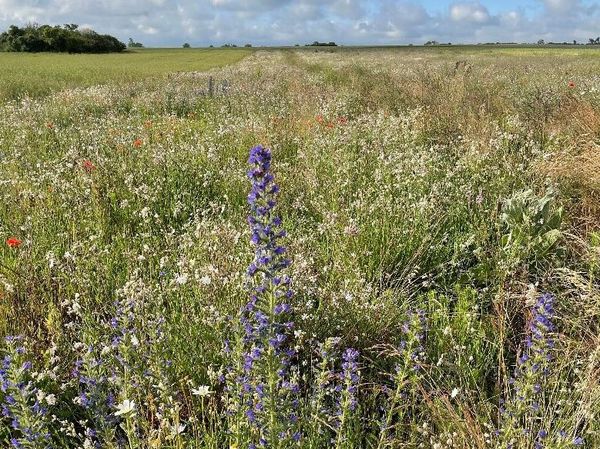Expertise
Increasing biodiversity – what does it cost?
Elke Plaas, Anika Bosse, Karsten Beutnagel | 27.04.2023
Biodiversity in agricultural landscapes has been declining for years. Agriculture has a special responsibility in this context. On the one hand, it is considered as contributor to this decline but on the other hand, as a land user, it also has the potential to contribute to preservation and increasing of biodiversity.

The new reform of the EUs common agricultural policy (CAP), which entered into force in 2023, will place greater focus on the implementation of biodiversity measures. In addition to existing regulations, such as minimum distances from water bodies, EU direct payments to farmers will be linked to compliance with compulsory ecological standards. These include for example in Germany, setting aside 4 % of arable land. Famers can additionally participate in voluntary programs (e. g. agri-environmental measures (AEM)).
For their participation they receive payments on a per area basis to compensate for the loss of income and extra costs for implementation. However, studies conducted by the Thünen Institute showed: many farmers have concerns about insufficient profitability and flexibility in the implementation of those measures and fear possible sanctions. This negatively influences the acceptance and uptake of AEM (Joormann and Schmidt 2017).
In the projects FInAl and F.R.A.N.Z., the Thünen Institute is working together with other project partners from science and agricultural practice on solutions to develop and implement biodiversity measures. Farmers receive full compensation for implementing the biodiversity measures based on the costs which are analysed by the economic research. The costs themselves consist of opportunity costs, production costs and potential production revenues of the measures. Opportunity costs refer to the lost contribution margin (benefits minus variable costs) of the alternative crop rotation. Production costs include the measure-specific costs for seed and operations carried out. In addition, transaction costs due to an increased need for coordination and time in applying for and documenting the measures by the farmer are considered.
Opportunity costs are the crucial point
The calculations show that the costs for biodiversity measures depend largely on whether the measure is “productive” or “unproductive”. “Productive” measures such as extensive cereals crops can still be marketed with some profit. “Unproductive” measures such as fallow land or wildflower strips are more expensive because even if ecological benefits are produced, the evolving costs are not offset by monetary revenues. The type of measure influences the cost structure mainly through different expenses for seed and labor (Bosse et al, 2022). However, opportunity costs have the greatest impact and account for up to 90 % of the total costs (see Figure 1).
Due to different site conditions, the crops grown and different marketing potentials, the opportunity costs vary greatly between the farms and regions. Particularly on favorable sites with high opportunity costs, the funding levels in the previous programs are therefore often not sufficient to compensate for the costs incurred through participation in voluntary agri-environmental schemes.
The all-in-one measure does not exist
By using public funds for the promotion of biodiversity, the question of cost-effectiveness of the investigated measures arises. It can be seen that certain measures (e. g. perennial wildflower strips and field margins) show notably positive effects on the target species studied. However, there is no single measure that can be recommended for every site. A mix of measures is necessary for optimal promotion. This mix can vary significantly depending on the region and target species. Of additional influence on the ecological effect is the landscape context and the location of the measure within the landscape.
For most of the investigated measures no direct causality could be found between the costs of measures and their ecological effect. Even with expensive measures, the high opportunity costs make up the largest share of the total costs. In addition, high opportunity costs seem more indicative of intensive agricultural practices. This could determine a lower ecological level, where ecological enhancement could be achieved more quickly.
Overall, the acceptance of biodiversity-promoting measures can be increased through a continuous joint exchange between all stakeholders that provides sufficient space for regional needs. Likewise, Cost-covering compensation is another prerequisite for a broad implementation of biodiversity measures.
Further information on the calculation of measure costs and their acceptance:
Bosse A, Stupak N, Sanders J (2022) Kosten biodiversitätsfördernder Maßnahmen im F.R.A.N.Z.-Projekt und deren Bestimmungsfaktoren: F.R.A.N.Z. Projektbericht. Braunschweig: Thünen-Institut für Betriebswirtschaft, 36 p
Joormann I, Schmidt TG (2017) F.R.A.N.Z.-Studie – Hindernisse und Perspektiven für mehr Biodiversität in der Agrarlandschaft. Braunschweig: Johann Heinrich von Thünen-Institut, 67 p, Thünen Working Paper 75

![[Translate to English:] Logo des Bundesministerium für Ernährung und Landwirtschaft](/media/allgemein/logos/BMEL_Logo.svg)